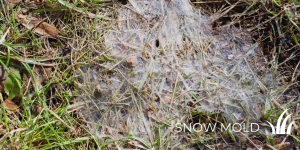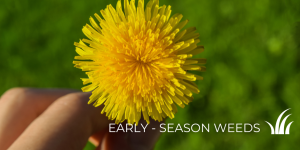
Winters Aftermath & How to Fix It Naturally
Spring is here, and as the snow melts away, your lawn is finally back in the spotlight. But instead of a lush green carpet, you might be greeted with patchy grass, stubborn weeds, or even strange fuzzy spots. After months of harsh winter conditions, your lawn needs a little help to bounce back. The good news? You don’t need harsh chemicals to get it looking its best. With the right natural solutions, you can tackle common early spring lawn problems and set the stage for a thicker, healthier lawn all season long. Here’s what to watch for—and how to fix it the right way.

Snow Mold: What It Is & How to Fix It
As the snow melts away, you might notice strange patches of white, gray, or even pink fuzz creeping across your lawn. This is snow mold, a common early spring lawn disease caused by long periods of snow cover and excessive moisture. If left untreated, it can weaken your grass and create the perfect conditions for weeds to take over.
🔴 PROBLEM: Snow mold thrives in damp, compacted areas where snow sat for extended periods. It suffocates grass, slowing its recovery from winter dormancy. While the damage may seem cosmetic at first, prolonged exposure can lead to thinning turf and an increased risk of weeds filling in the gaps.
✅ SOLUTION: The good news is that snow mold usually clears up on its own with the right care. Here’s how to speed up the process:
-
Lightly rake affected areas to break up the mold and improve airflow.
-
Let the sun and wind do the work—drying out the lawn naturally will help kill the fungus.
-
Mow at the proper height once the lawn is actively growing to encourage healthy recovery.
By addressing snow mold early, you can prevent long-term damage and help your lawn bounce back faster.

Thin or Patchy Grass: Why Your Lawn Looks Weak After Winter
After a long Northeast Ohio winter, you might notice thin or bare patches in your lawn. Cold temperatures, road salt, and compacted soil take a toll, leaving turf weak and struggling to recover. Without intervention, these problem areas can become a breeding ground for weeds and further lawn decline.
🔴 PROBLEM: Winter stress, salt damage, and nutrient depletion are the main culprits behind thin or patchy grass. Snow and ice compact the soil, suffocating roots, while road salt dries out and weakens grass near sidewalks and driveways. Without the right nutrients, your lawn may struggle to green up in the spring, leading to slow growth and bare spots.
✅ SOLUTION: Strengthen your lawn’s recovery with these natural fixes:
-
Overseed with the right grass seed to fill in bare areas and promote thicker turf.
-
Spread a thin layer of compost to restore nutrients and improve soil health.
-
Water deeply and infrequently to encourage strong, deep root growth that supports long-term lawn health.
By addressing these issues early, you’ll set your lawn up for a greener, thicker growing season.

Early-Season Weeds: Stopping Weeds Before They Take Over
As temperatures rise, so do the first signs of unwanted weeds like dandelions and crabgrass. These aggressive invaders thrive in thin or stressed lawns, quickly taking up space and competing with grass for nutrients. Once they establish, they can spread fast, making them harder to control later in the season.
🔴 PROBLEM: Weeds like dandelions and crabgrass emerge early and take advantage of weak or bare spots in your lawn. If left unchecked, they can choke out healthy grass, forcing homeowners into a constant battle to keep their lawn looking its best.
✅ SOLUTION: The best way to prevent weeds is to stop them before they even start. Here’s how:
-
Apply our all-natural, original-recipe pre-emergent to create a protective barrier against weed seeds while keeping your lawn free of unnecessary chemicals.
-
Avoid aerating in the spring—aeration opens up the soil and can unintentionally create space for weeds to take root. Instead, keep the lawn thick and undisturbed so weeds don’t have a chance to fill in gaps.
-
Maintain a dense, healthy lawn by mowing at the correct height and following a proper fertilization plan.
By taking a proactive approach, you can keep weeds from gaining a foothold and enjoy a lush, weed-free lawn all season long.

Get Pricing and Get on Our Schedule
We’ve seen it all, and we know exactly what it takes to create the perfect lawn. The final step to a greener, healthier yard starts with us. Did you know you can get your pricing in just minutes? Start HERE and find out! No waiting, no hassle—just a straightforward way to get started. Lock in your spot today and set your lawn up for success this season!
Still wanting to learn more? You Can Read More HERE
